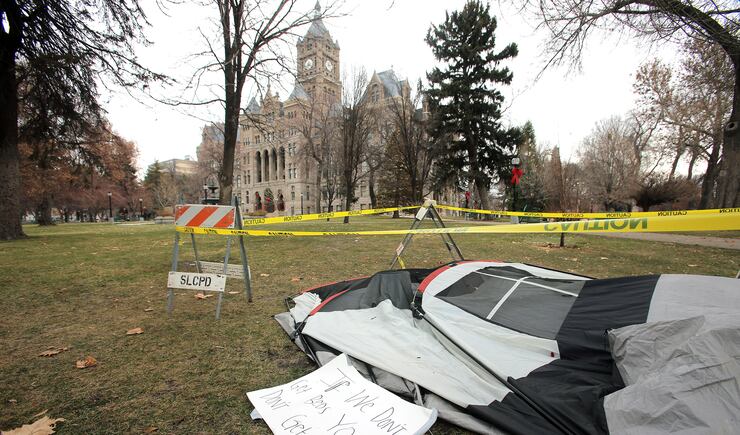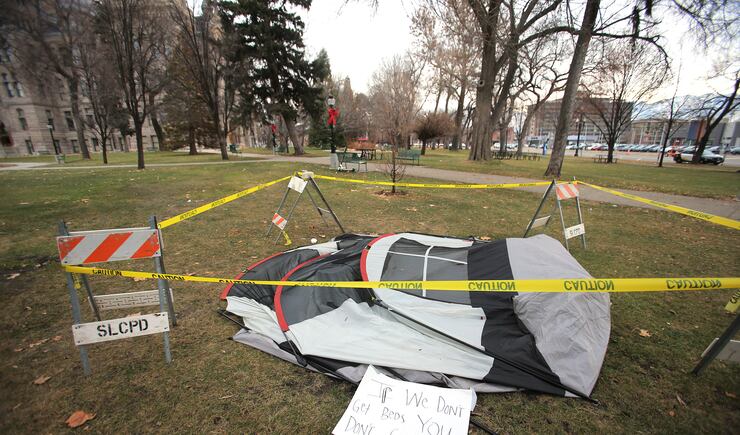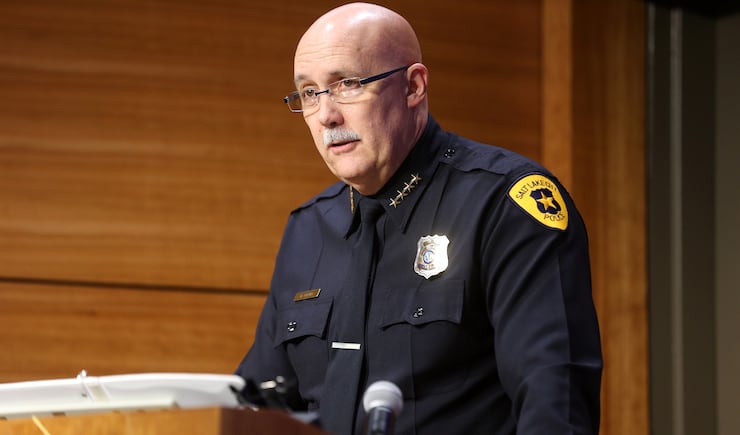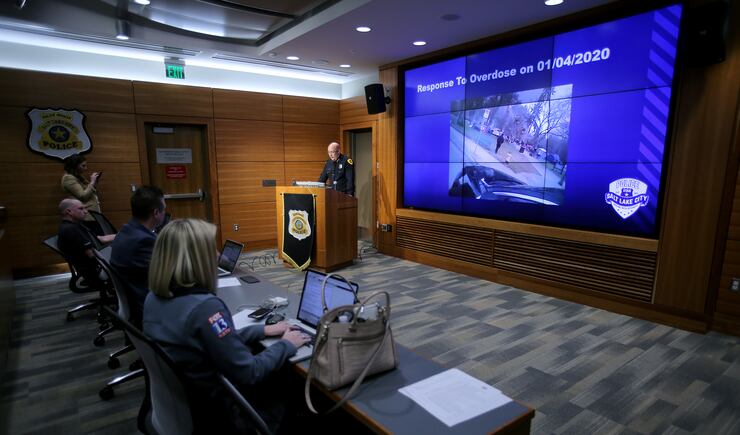SALT LAKE CITY — Demonstrators clashed with police in riot gear outside the Salt Lake City-County Building late Saturday and early Sunday in a boisterous, turbulent confrontation that came as officers sought to clear out several tents there set up as a display of criticism over how the city handles its homeless population.
With chants like “no beds, no peace,” more than 100 people with the Take Shelter Coalition and other groups linked arms about 11 p.m., the same time officers told reporters they would enforce a curfew and no-camping ordinance on the lawn.
More than 100 officers and civilian police employees carried out the operation.
“We have been accused of being heavy-handed and violent. I am here to tell you what I am personally seeing has been a model of restraint and professionalism in the face of some of the most inciting and vulgar verbal assaults,” Salt Lake Police Chief Mike Brown said of his officers during a news conference Sunday afternoon.
“Key members of the group continue to find causes that put them in direct confrontation with police in hopes of instigating an encounter that fits their narrative. This puts officers and the public in dangerous situations,” he said.
Seventeen people were arrested; four were booked into the Salt Lake County Jail for investigation of resisting arrest, violating park curfew, interfering with arresting officers, criminal trespass, disorderly conduct and failure to disperse. Thirteen received citations.
Many of the protesters were the same ones who stormed the Chamber of Commerce Building last year to protest the construction of the Utah Inland Port, according to Brown. That demonstration escalated into violence after some protesters refused to leave. Both officers and protesters were seen throwing punches.
Brown said the public safety issues and illegality of the encampment in a public park after the 11 p.m. curfew made Saturday night’s raid necessary. Earlier Saturday, first responders were called to help a man who had overdosed at the encampment, and were slowed down in reaching him due to the gathering.
Though the man survived, Brown said he fears a similar incident to one in 2011, when a man died from a combination of a drug overdose and carbon monoxide poisoning due to a space heater inside his tent at an Occupy Salt Lake protest.
Before the encampment was cleared Sunday, cries of protest were met with dueling broadcasts from police speakers that blared warnings of arrest and prosecution for those who did not leave. The messages from Salt Lake police announced there were 79 open beds available that night for the city’s homeless, a claim refuted by several demonstrators.
“We’ve called every day for the past about month and a half, and still there’s so many beds that are not available. They’re always full,” said Mike Sanchez, one of the protesters, before the encampment was broken up.
“We’re just trying to do our part here to make the environment better for these unsheltered folks. They just have no place to go,” he said.
Take Shelter Coalition said its members were camping to protest what it described as full shelters after the county opened three new homeless resource centers, eliminating the downtown Road Home shelter. The coalition called for the creation of a new downtown shelter.
“These unsheltered folks don’t have a voice for themselves. ... I’m prepared to take a stand and do whatever it takes to get these unsheltered folks a place to live. We just want them to have somewhere safe. There’s so many taxpayer dollars going to building new companies, building new buildings, and that’s unnecessary,” Sanchez said.










Early Friday, people experiencing homelessness on 500 South were awakened and told by the protesters to move to the protest encampment, said police spokeswoman Christina Judd.
In a video of a conversation with a man and woman played during the news conference, the woman can be heard telling an officer about that early-morning encounter with protesters. The woman said she and the man didn’t want to go to Washington Square, and that they weren’t “looking to get into trouble.” But they recalled seeing protesters push some homeless people’s shopping carts to the park themselves.
Homelessness leaders have been challenged with dispelling confusion about the new system and figuring out what to do with those who refuse to sleep in one of the centers or don’t want to leave the downtown area.
Preston Cochrane, executive director of Shelter the Homeless, said Sunday that on average during the week ending Jan. 1, there were between 651 and 697 beds out of the total 700 occupied in the three homeless centers. An average of 680 beds were filled each night, he said.
But between 65 and 70 beds become available every night at 8 p.m., and then get mostly filled within about two hours, according to Cochrane. An overflow shelter at St. Vincent de Paul Dining Hall contains 58 beds, which are full most nights, he added.
A warming center also at the dining hall usually has room, as “people come and go throughout the night,” Cochrane said.
“No one is turned away from resources,” he said, adding that a free shuttle runs between the homeless centers, the Weigand Center and the city library every afternoon between 2 p.m. and 10 p.m.
On Thursday, Jan. 2, the most recent day with available occupancy numbers, the three resource centers were nearly full at the end of the night, with 13 beds left, said Christina Davis, spokeswoman for the Department of Workforce Services, which is aiding the transition to the homeless centers.
She said because dozens of beds open up at 8 p.m. each night as people don’t return to the shelter, the time someone calls looking for a bed makes a difference.
When beds run out for the night for those who go into the centers later, the warming overflow area is available to them, Davis said. The shelter operators have also been working with clients to offer motel vouchers.
She said homeless advocates’ main concern about the protest is that those experiencing homelessness will hear protesters’ concerns and believe there isn’t room or resources for them, and won’t check for themselves. The homeless system also offers help finding treatment centers or permanent housing, Davis said.
A video the department released on Friday showed a small group of protesters taunting police and repeatedly cursing at them.
Most of the campers walked across the street late Saturday before about 40 officers slowly approached the encampment over the course of about an hour with shields and helmets, some wielding batons. The officers took several paces and paused for minutes at a time before advancing again as bystanders took video on their phones and four ACLU legal observers recorded the encounter.
About a dozen demonstrators within the encampment locked arms and sang, surrounded by a barricade of picnic tables, cardboard boxes, a bike and a shopping cart. Officers appeared to step through the camp and force several demonstrators to the ground, breaking the group apart.
At one time, a masked protester began throwing bottles at officers, according to a timeline of the operation provided by police. No officers were injured, Brown said. When others began throwing liquids at the officers, police fired nonlethal foam rounds at them with marking paint.
Several yelled at officers, sometimes hurling expletives. Some demonstrators shoved back at police shields or cried as the law enforcement line advanced toward the southwest corner of the square. By about 1 a.m. Sunday, most either left or were led away by officers with their hands behind their backs.
In a statement Friday, Salt Lake City Mayor Jackie Biskupski and Mayor-elect Erin Mendenhall issued a joint statement saying the protesters have declined invitations to speak with city officials about their concerns. Officers on Friday offered members of the encampment information about “city ordinances related to First Amendment demonstrations and use of public spaces.”
“As the mayor and mayor-elect of Salt Lake City, we acknowledge, understand, and share the public’s concern about people sleeping outdoors in winter conditions and their ability to access safe shelter,” the statement reads.
“Salt Lake City has been working on and investing in solutions that treat those experiencing homelessness with dignity. It is our goal and responsibility to ensure that everyone is safe from harm. That includes informing Salt Lake County when public health concerns arise,” it continues.
The statement went on to describe resources and efforts made to help the homeless community, and the effort that went into creating the three new homeless centers. The mayor and mayor-elect also promised that “no cold weather gear will be taken from those in an active encampment between Nov. 1 through March 31.”
Before the arrests, demonstrator Ivan Cardenas, 37, of Murray, said the display was necessary to draw attention to harassment of homeless people in Salt Lake City and what he said is a lack of available shelter beds.
”I could have ended up here,” said Cardenas, adding he is now in recovery for substance abuse. “I could have very much been one of these people, homeless out here. I know several people that are doing better in life and they were out here. There has to be a better solution.”
A woman at the protest who refused to share her name said the encampment had so far been peaceful and cleaned up its trash. “There’s just no need for police presence like this,” she said, adding that she feared the confrontation would turn violent.
Some protestors emphasized to police the U.S. 9th Circuit Court of Appeals last year ruled it is unconstitutional to prosecute homeless people for sleeping on public property when they can’t access shelters, although the ruling does not apply to Utah, which is in the 10th Circuit.
After members of the encampment were arrested, police took makeshift mugshots, writing the names of individual demonstrators and their birth dates on a whiteboard, then having them sit on a curb as the demonstrators continued to sing.
“Our officers have shown great restraint in dealing with these individuals. We have planned and carried out a strategic removal of the protesters tonight. We have provided resources for those that are experiencing homelessness. We invite a civil dialogue to address concerns,” police tweeted after the raid.
Property of those who were arrested was being held in evidence for safe-keeping, according to another police tweet, and no cold weather items were taken from campers experiencing homelessness.
According to public lands workers, they removed an estimated six to seven tons of trash from the site, Brown said.
Officers stayed in the area after the raid while public lands workers arrived to clean up “the mess left behind,” the department said, sharing photos of tilted tents, piles of bags, and clothing strewn on the ground.













